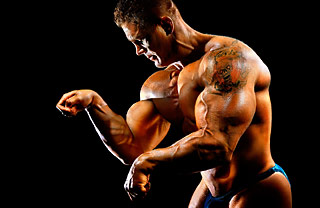 Hi and welcome to this edition of Workshop at the Ranch. I really enjoy teaching photography and do so through these articles and through a variety of workshops and lectures each year. Rich Clarkson’s Sports Photography Workshop is quite possibly the finest workshop around. His sports workshop takes place during the last week of June each year and is located in the Colorado Springs area where the US Olympic Training Center plays host to the 60 attendees and staff. There are many other activities and sports that the students photograph outside the USOTC like Colorado Rockies baseball and the Pikes Peak Hill Climb motorsports event plus faculty lectures and presentations, lighting classes, business discussions, portfolio reviews and in general a great week of learning and fun.
Hi and welcome to this edition of Workshop at the Ranch. I really enjoy teaching photography and do so through these articles and through a variety of workshops and lectures each year. Rich Clarkson’s Sports Photography Workshop is quite possibly the finest workshop around. His sports workshop takes place during the last week of June each year and is located in the Colorado Springs area where the US Olympic Training Center plays host to the 60 attendees and staff. There are many other activities and sports that the students photograph outside the USOTC like Colorado Rockies baseball and the Pikes Peak Hill Climb motorsports event plus faculty lectures and presentations, lighting classes, business discussions, portfolio reviews and in general a great week of learning and fun.
Hi and welcome to this edition of Workshop at the Ranch. I really enjoy teaching photography and do so through these articles and through a variety of workshops and lectures each year. Rich Clarkson’s Sports Photography Workshop is quite possibly the finest workshop around. His sports workshop takes place during the last week of June each year and is located in the Colorado Springs area where the US Olympic Training Center plays host to the 60 attendees and staff. There are many other activities and sports that the students photograph outside the USOTC like Colorado Rockies baseball and the Pikes Peak Hill Climb motorsports event plus faculty lectures and presentations, lighting classes, business discussions, portfolio reviews and in general a great week of learning and fun.
I have been a part of Rich’s workshop faculty for 20 years. During the last several workshops I have taught arena sport strobe lighting classes at the USOTC Aquatic Center where students learned how to photograph Olympic caliber swimmers using sport strobe lighting. This year, however, I turned that class instruction over to a great teacher of arena lighting Shawn Cullen from Sports Illustrated so I could begin a new class on small strobe location lighting using the Nikon SB800 Speedlights. The new class was very well received as students learned how to light a subject with these small off camera flash units.
The class began with basic operation and placement of the speedlights and then we worked our way up to more creative lighting situations. We started with one Nikon SB800 Speedlight on our subject … then added another and another and another….. little by little we as a class arranged the speedlights, took a shot and took a look, then rearranged the lights again and again until we liked the image being produced. I had made arrangements to have Andy Haman, the current Super Heavy Weight Mr. Colorado as our model for the class. Andy was preparing for the Mr. USA competition and was in great form for our lighting class. His perfect physic and wonderful attitude brought instant success to the class. Here are some of my example pictures made before the class took over the camera and made pictures of their own portfolios ………
|
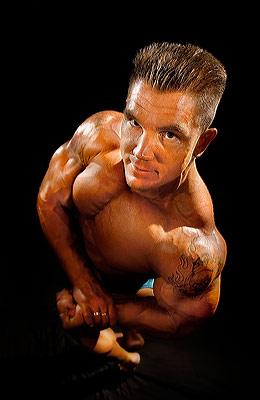 Image #1 Three Light Set Up … Our class began with some basic lighting discussion and operation of the SB800 Speedlights (for additional information and images made with Nikon SB800 Speedlights check out past editions of Workshop at the Ranch). I used one SB800 (no power output) as a MASTER on the hotshoe of my Nikon D200 and a Nikon 17-55mm Lens. (NOTE: I could have used a Nikon SU800 Commander as my Master but I chose the SB800 to demonstrate to the class the most basic set up.) An inexpensive bolt of black cloth was purchased at the local Cloth World and was used as the backdrop. This would be a collective learning process by which I directed the students via questions, answers, trial and error “take a shot and take a look” and some humor to arrive at this classic three light arrangement. The Classic Three Light formula … two SB800s are placed slightly in front of Mr Colorado, … #1 is 3/4 angled at his right shoulder and #2 is 3/4 angled at his left shoulder. The third SB800 is place slightly behind and 3/4 angled towards his back. The SB800s are in the REMOTE mode and are mounted to Bogen Lightstands with Bogen 175F Clamps made for small off camera strobes. Each of these three speedlights are located approximately 4 feet from Andy. The two front SB800s are zoomed to 105mm (illuminating only his upper body) while the back SB800 is set at 24mm (Illuminating his entire back and legs.) All remote SB800s are in i-TTL Mode. Nikon D200, ISO100, 1/125 at f4.5, Nikon 17-55mm Lens, WB8300, Three Nikon SB800 Speedlights used as Remotes Power Output 0.0 and One SB800 as the Master (no power output), Bogen Lightstands and Bogen 175F Clamps, Lexar 4G Flash Card. Image #1 Three Light Set Up … Our class began with some basic lighting discussion and operation of the SB800 Speedlights (for additional information and images made with Nikon SB800 Speedlights check out past editions of Workshop at the Ranch). I used one SB800 (no power output) as a MASTER on the hotshoe of my Nikon D200 and a Nikon 17-55mm Lens. (NOTE: I could have used a Nikon SU800 Commander as my Master but I chose the SB800 to demonstrate to the class the most basic set up.) An inexpensive bolt of black cloth was purchased at the local Cloth World and was used as the backdrop. This would be a collective learning process by which I directed the students via questions, answers, trial and error “take a shot and take a look” and some humor to arrive at this classic three light arrangement. The Classic Three Light formula … two SB800s are placed slightly in front of Mr Colorado, … #1 is 3/4 angled at his right shoulder and #2 is 3/4 angled at his left shoulder. The third SB800 is place slightly behind and 3/4 angled towards his back. The SB800s are in the REMOTE mode and are mounted to Bogen Lightstands with Bogen 175F Clamps made for small off camera strobes. Each of these three speedlights are located approximately 4 feet from Andy. The two front SB800s are zoomed to 105mm (illuminating only his upper body) while the back SB800 is set at 24mm (Illuminating his entire back and legs.) All remote SB800s are in i-TTL Mode. Nikon D200, ISO100, 1/125 at f4.5, Nikon 17-55mm Lens, WB8300, Three Nikon SB800 Speedlights used as Remotes Power Output 0.0 and One SB800 as the Master (no power output), Bogen Lightstands and Bogen 175F Clamps, Lexar 4G Flash Card.
|
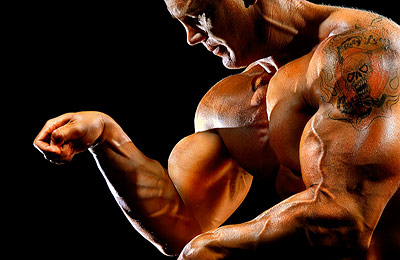 Image #2 Five Light Set Up … With our class accomplishment of the classic Three Light portrait we as a class moved forward in an effort to produce a more creative lighting situation and a more dramatic image of this years Mr. Colorado. I explained to the class that I wanted to “highlight” specific areas of Andy’s physic. The zooming capabilities of the SB800 is terrific but I wanted to concentrate the light even more than the SB800s 105mm allows. The answer was to add a LumiQuest Snoot to each remote SB800. The difference is evident. As Andy demonstrated one of his world class poses we arranged One speedlight to highlight his biceps, One to highlight his abdominal muscles, One to highlight his shoulders and neck, One to highlight his lower back and hip, and we used One that was handheld to highlight his face. Nikon D200, ISO100, 1/125 at f4.5, Nikon 17-55mm Lens, WB8300, Five Nikon SB800 Speedlights used as Remotes each with a LumiQuest Snoot (power output 0.0), One SB800 as the Master (no power output), Bogen Lightstands and Bogen 175F Clamps, Lexar 4G Flash Card. Image #2 Five Light Set Up … With our class accomplishment of the classic Three Light portrait we as a class moved forward in an effort to produce a more creative lighting situation and a more dramatic image of this years Mr. Colorado. I explained to the class that I wanted to “highlight” specific areas of Andy’s physic. The zooming capabilities of the SB800 is terrific but I wanted to concentrate the light even more than the SB800s 105mm allows. The answer was to add a LumiQuest Snoot to each remote SB800. The difference is evident. As Andy demonstrated one of his world class poses we arranged One speedlight to highlight his biceps, One to highlight his abdominal muscles, One to highlight his shoulders and neck, One to highlight his lower back and hip, and we used One that was handheld to highlight his face. Nikon D200, ISO100, 1/125 at f4.5, Nikon 17-55mm Lens, WB8300, Five Nikon SB800 Speedlights used as Remotes each with a LumiQuest Snoot (power output 0.0), One SB800 as the Master (no power output), Bogen Lightstands and Bogen 175F Clamps, Lexar 4G Flash Card. |
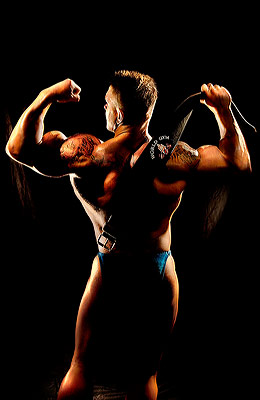 Image #3 Get Creative … Image #3 Get Creative … With this five light arrangement [4 clamped to lightstands ( 2 on each stand ) and 1 handheld ( by a student volunteer,)] I suggested we turn our subject around and see his back and shoulders while displaying the classic “Double Biceps” pose. We did a quick rearrangement of our 4 lights on the lightstands from the previous picture to illuminate his arms and legs and also had our student holding the one handheld SB800 move into a position to light Andy’s face. I took a shot and took a look, and found the image very compelling. I love the way the LumiQuest Snoot narrows the spill of light and creates isolated pockets of light on various areas of Andy’s body. Nikon D200, ISO100, 1/125 at f4.5, Nikon 17-55mm Lens, WB8300, Five Nikon SB800 Speedlights used as Remotes each with a LumiQuest Snoot (power output 0.0), One Nikon SB800 as the Master (no power output), Bogen Lightstands and 175F Clamps, Lexar 4G Flash Card.
|
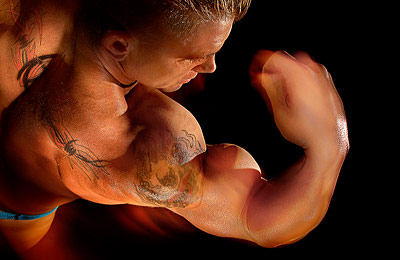 Image #4 More Creativity … Up to this point lighting was our key to creativity, but I always want more …. So I suggested to the class that we explore something besides lighting to set a creative mood. We settled on a slower shutter speed and asked Andy to raise his arm into a single biceps pose. This slower shutter speed (1/13 of a second) allowed some of the ambient light from the hotel room to slightly expose our subject. The combination of the ambient light and the SB800 Speedlight made for a very interesting motion blur (ambient) and frozen action (SB800) combination. Nikon D200, ISO100, 1/13 at f4.5, Nikon 17-55mm Lens, WB8300, Three Nikon SB800 Speedlights were used as Remotes, each with a LumiQuest Snoot (power output 0.0), One SB800 as the Master (no power output), Bogen Lightstands and Bogen 175F Clamps, Rear Curtain Sync was activated on the D200, Lexar 4G Flash Card. We repositioned our three remote SB800 Speedlights for this pose and had Andy swing his arm into the single biceps position while we took the shot. One SB800 with a snoot aimed at Andy’s face, One SB800 with a snoot aimed at Andy’s biceps and shoulders, and One SB800 with a snoot aimed at his hip and leg. I really like the feeling created with the combination of blurred movement and frozen action with the SB800 Speedlights. Image #4 More Creativity … Up to this point lighting was our key to creativity, but I always want more …. So I suggested to the class that we explore something besides lighting to set a creative mood. We settled on a slower shutter speed and asked Andy to raise his arm into a single biceps pose. This slower shutter speed (1/13 of a second) allowed some of the ambient light from the hotel room to slightly expose our subject. The combination of the ambient light and the SB800 Speedlight made for a very interesting motion blur (ambient) and frozen action (SB800) combination. Nikon D200, ISO100, 1/13 at f4.5, Nikon 17-55mm Lens, WB8300, Three Nikon SB800 Speedlights were used as Remotes, each with a LumiQuest Snoot (power output 0.0), One SB800 as the Master (no power output), Bogen Lightstands and Bogen 175F Clamps, Rear Curtain Sync was activated on the D200, Lexar 4G Flash Card. We repositioned our three remote SB800 Speedlights for this pose and had Andy swing his arm into the single biceps position while we took the shot. One SB800 with a snoot aimed at Andy’s face, One SB800 with a snoot aimed at Andy’s biceps and shoulders, and One SB800 with a snoot aimed at his hip and leg. I really like the feeling created with the combination of blurred movement and frozen action with the SB800 Speedlights.
|
Well, ………….. I hope this WATR encourages all of you to investigate the use of small strobe units off camera. It just takes a little time and experimentation to see what off camera lighting can do for your pictures. You will be amazed at the results that even one or two lights can create when used off camera.
Many thanks go out to Andy Haman for helping our class and Best of Luck at the Mr. USA competition.
Attending a workshop is one of the best ways to learn photographic techniques, business, camera knowledge and connect with professionals plus add new images to your own portfolio. Rich Clarkson’s Sports Photography Workshop in Colorado Springs and his Photography at the Summit workshop held in Jackson Hole, Wyoming during early October and late April are some of the finest workshops I’m involved with each year. My lighting class session is only one of many instructional situations that students can participate in during the week. Rich brings in a great staff of the nations leading photographers and editors as program instructors. For more information on Rich Clarkson’s workshops logon to www.richclarkson.com and see if one of his workshops is what you are looking for. If so, I’ll see you there.
Adios, ……………….. Dave
![]() Hi and welcome to this edition of Workshop at the Ranch. I really enjoy teaching photography and do so through these articles and through a variety of workshops and lectures each year. Rich Clarkson’s Sports Photography Workshop is quite possibly the finest workshop around. His sports workshop takes place during the last week of June each year and is located in the Colorado Springs area where the US Olympic Training Center plays host to the 60 attendees and staff. There are many other activities and sports that the students photograph outside the USOTC like Colorado Rockies baseball and the Pikes Peak Hill Climb motorsports event plus faculty lectures and presentations, lighting classes, business discussions, portfolio reviews and in general a great week of learning and fun.
Hi and welcome to this edition of Workshop at the Ranch. I really enjoy teaching photography and do so through these articles and through a variety of workshops and lectures each year. Rich Clarkson’s Sports Photography Workshop is quite possibly the finest workshop around. His sports workshop takes place during the last week of June each year and is located in the Colorado Springs area where the US Olympic Training Center plays host to the 60 attendees and staff. There are many other activities and sports that the students photograph outside the USOTC like Colorado Rockies baseball and the Pikes Peak Hill Climb motorsports event plus faculty lectures and presentations, lighting classes, business discussions, portfolio reviews and in general a great week of learning and fun. 





